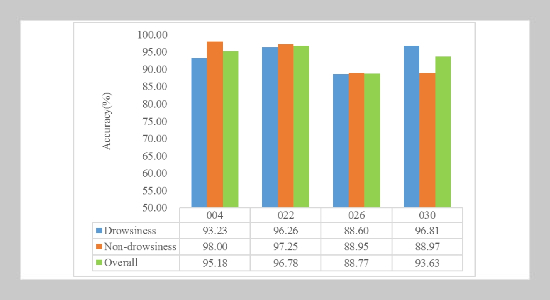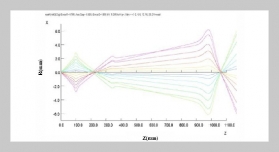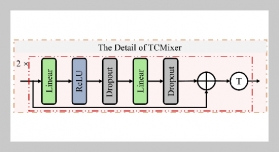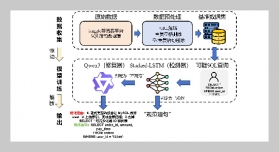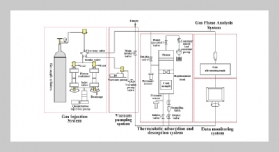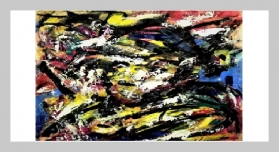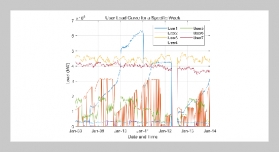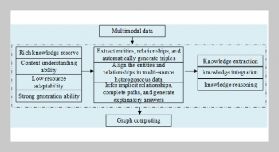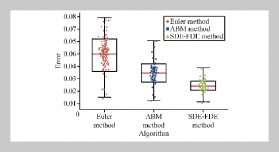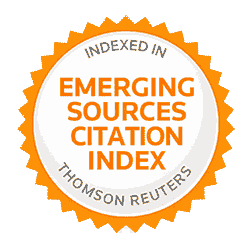- [1] M. Doudou, A. Bouabdallah, and V. Berge-Cherfaoui, (2020) “Driver drowsiness measurement technologies: Current research, market solutions, and challenges" In�ternational Journal of Intelligent Transportation Systems Research 18: 297–319. DOI: 10.1007/s13177-019-00199-w.
- [2] Drowsy Driving NHTSA Reports. Accessed: March 2020. https: //www.nhtsa.gov/risky-driving/drowsy�driving.
- [3] S. Kaplan, M. A. Guvensan, A. G. Yavuz, and Y. Kar�alurt, (2015) “Driver behavior analysis for safe driving: A survey" IEEE Transactions on Intelligent Trans�portation Systems 16(6): 3017–3032. DOI: 10.1109/TITS.2015.2462084.
- [4] Y. Albadawi, M. Takruri, and M. Awad, (2022) “A re�view of recent developments in driver drowsiness detection systems" Sensors 22(5): 2069. DOI: 10.3390/s22052069.
- [5] T. Åkerstedt and M. Gillberg, (1990) “Subjective and objective sleepiness in the active individual" Interna�tional journal of neuroscience 52(1-2): 29–37. DOI: 10.3109/00207459008994241.
- [6] I. Stancin, M. Cifrek, and A. Jovic, (2021) “A review of EEG signal features and their application in driver drowsi�ness detection systems" Sensors 21(11): 3786. DOI: 10.3390/s21113786.
- [7] S. Soares, S. Ferreira, and A. Couto, (2020) “Driving simulator experiments to study drowsiness: A systematic review" Traffic injury prevention 21(1): 29–37. DOI: 10.1080/15389588.2019.1706088.
- [8] T. Li, T. Zhang, Y. Zhang, and L. Yang, (2022) “Driver fatigue detection method based on human pose information entropy" Journal of advanced transportation 2022: DOI: 10.1155/2022/7213841.
- [9] K. Fujiwara, E. Abe, K. Kamata, C. Nakayama, Y. Suzuki, T. Yamakawa, T. Hiraoka, M. Kano, Y. Sumi, F. Masuda, et al., (2018) “Heart rate variability-based driver drowsiness detection and its validation with EEG" IEEE transactions on biomedical engineering 66(6): 1769–1778. DOI: 10.1109/TBME.2018.2879346.
- [10] Y. Jiang, Y. Zhang, C. Lin, D. Wu, and C.-T. Lin, (2020) “EEG-based driver drowsiness estimation using an online multi-view and transfer TSK fuzzy system" IEEE Trans�actions on Intelligent Transportation Systems 22(3): 1752–1764. DOI: 10.1109/TITS.2020.2973673.
- [11] K. T. Chui, K. F. Tsang, H. R. Chi, B. W. K. Ling, and C. K. Wu, (2016) “An accurate ECG-based transportation safety drowsiness detection scheme" IEEE Transactions on Industrial Informatics 12(4): 1438–1452. DOI: 10.1109/TII.2016.2573259.
- [12] F. Wang, Q. Xu, and R. Fu, (2019) “Study on the effect of man-machine response mode to relieve driving fatigue based on EEG and EOG" Sensors 19(22): 4883. DOI: 10.3390/s19224883.
- [13] C. Caponecchia and A. Williamson, (2018) “Drowsi�ness and driving performance on commuter trips" Jour�nal of safety research 66: 179–186. DOI: 10.1016/j.jsr.2018.07.003.
- [14] J. Wörle, B. Metz, M. B. Steinborn, L. Huestegge, and M. Baumann, (2021) “Differential effects of driver sleepiness and sleep inertia on driving behavior" Trans�portation research part F: traffic psychology and behaviour 82: 111–120. DOI: 10.1016/j.trf.2021.08.001.
- [15] M. Shahverdy, M. Fathy, R. Berangi, and M. Sabokrou, (2020) “Driver behavior detection and classi�fication using deep convolutional neural networks" Ex�pert Systems with Applications 149: 113240. DOI: 10.1016/j.eswa.2020.113240.
- [16] R. Huang, Y. Wang, Z. Li, Z. Lei, and Y. Xu, (2020) “RF-DCM: multi-granularity deep convolutional model based on feature recalibration and fusion for driver fatigue detection" IEEE Transactions on Intelligent Trans�portation Systems 23(1): 630–640. DOI: 10.1109/TITS. 2020.3017513.
- [17] B. Mandal, L. Li, G. S. Wang, and J. Lin, (2016) “To�wards detection of bus driver fatigue based on robust vi�sual analysis of eye state" IEEE Transactions on Intel�ligent Transportation Systems 18(3): 545–557. DOI: 10.1109/TITS.2016.2582900.
- [18] S. Bakheet and A. Al-Hamadi, (2021) “A framework for instantaneous driver drowsiness detection based on improved HOG features and naıve Bayesian classifi�cation" Brain Sciences 11(2): 240. DOI: 10.3390/brainsci11020240.
- [19] S. Jamshidi, R. Azmi, M. Sharghi, and M. Soryani, (2021) “Hierarchical deep neural networks to detect driver drowsiness" Multimedia Tools and Applications 80: 16045–16058. DOI: 10.1007/s11042-021-10542-7.
- [20] L. Zhang, F. Liu, and J. Tang, (2015) “Real-time sys�tem for driver fatigue detection by RGB-D camera" ACM Transactions on Intelligent Systems and Technol�ogy (TIST) 6(2): 1–17. DOI: 10.1145/2629482.
- [21] S. Mehta, S. Dadhich, S. Gumber, and A. Jadhav Bhatt. “Real-time driver drowsiness detection system using eye aspect ratio and eye closure ratio”. In: Proceed�ings of international conference on sustainable comput�ing in science, technology and management (SUSCOM), Amity University Rajasthan, Jaipur-India. 2019. DOI: 10.2139/ssrn.3356401.
- [22] M. H. Baccour, F. Driewer, E. Kasneci, and W. Rosen�stiel. “Camera-based eye blink detection algorithm for assessing driver drowsiness”. In: 2019 IEEE Intel�ligent Vehicles Symposium (IV). IEEE. 2019, 987–993. DOI: 10.1109/IVS.2019.8813871.
- [23] M. Dreißig, M. H. Baccour, T. Schäck, and E. Kas�neci. “Driver drowsiness classification based on eye blink and head movement features using the k-NN algorithm”. In: 2020 IEEE Symposium Series on Compu�tational Intelligence (SSCI). IEEE. 2020, 889–896. DOI: 10.1109/SSCI47803.2020.9308133.
- [24] S. Yin, L. Wang, M. Shafiq, L. Teng, A. A. Laghari, and M. F. Khan, (2023) “G2Grad-CAMRL: An Object Detection and Interpretation Model Based on Gradient�weighted Class Activation Mapping and Reinforcement Learning in Remote Sensing Images" IEEE Journal of Selected Topics in Applied Earth Observations and Remote Sensing: DOI: 10.1109/JSTARS.2023. 3241405.
- [25] T. Zhu, C. Zhang, T. Wu, Z. Ouyang, H. Li, X. Na, J. Liang, and W. Li, (2022) “Research on a real-time driver fatigue detection algorithm based on facial video se�quences" Applied Sciences 12(4): 2224. DOI: 10.3390/app12042224.
- [26] B. K. Sava¸s and Y. Becerikli, (2020) “Real time driver fatigue detection system based on multi-task ConNN" Ieee Access 8: 12491–12498. DOI: 10.1109/ACCESS.2020.2963960.
- [27] H. Yang, L. Liu, W. Min, X. Yang, and X. Xiong, (2020) “Driver yawning detection based on subtle facial action recognition" IEEE Transactions on Multimedia 23: 572–583. DOI: 10.1109/TMM.2020.2985536.
- [28] M.-H. Sigari, M. Fathy, and M. Soryani, (2013) “A driver face monitoring system for fatigue and distraction detection" International journal of vehicular tech�nology 2013: 1–11. DOI: 10.1155/2013/263983.
- [29] M.-H. Sigari, M.-R. Pourshahabi, M. Soryani, and M. Fathy, (2014) “A review on driver face monitoring sys�tems for fatigue and distraction detection" International Journal of Advanced Science and Technology 64: 73–100.
- [30] M. Ye, W. Zhang, P. Cao, and K. Liu, (2021) “Driver fatigue detection based on residual channel attention network and head pose estimation" Applied Sciences 11(19): 9195. DOI: 10.3390/app11199195.
- [31] T. Soukupova and J. Cech. “Eye blink detection us�ing facial landmarks”. In: 21st computer vision winter workshop, Rimske Toplice, Slovenia. 2016, 2.
- [32] A. Dosovitskiy, L. Beyer, A. Kolesnikov, D. Weis�senborn, X. Zhai, T. Unterthiner, M. Dehghani, M. Minderer, G. Heigold, S. Gelly, et al., (2020) “An image is worth 16x16 words: Transformers for image recognition at scale" arXiv preprint arXiv:2010.11929:
- [33] C.-H. Weng, Y.-H. Lai, and S.-H. Lai. “Driver drowsi�ness detection via a hierarchical temporal deep belief network”. In: Computer Vision–ACCV 2016 Workshops: ACCV 2016 International Workshops, Taipei, Taiwan, November 20-24, 2016, Revised Selected Papers, Part III 13. Springer. 2017, 117–133. DOI: 10.1007/978-3-319-54526-4_9.
- [34] S. Park, F. Pan, S. Kang, and C. D. Yoo. “Driver drowsiness detection system based on feature repre�sentation learning using various deep networks”. In: Asian Conference on Computer Vision. Springer. 2016, 154–164. DOI: 10.1007/978-3-319-54526-4_12.
- [35] L. Celona, L. Mammana, S. Bianco, and R. Schettini. “A multi-task CNN framework for driver face moni�toring”. In: 2018 IEEE 8th International Conference on Consumer Electronics-Berlin (ICCE-Berlin). IEEE. 2018, 1–4. DOI: 10.1109/ICCE-Berlin.2018.8576244.
- [36] M. Dua, Shakshi, R. Singla, S. Raj, and A. Jangra, (2021) “Deep CNN models-based ensemble approach to driver drowsiness detection" Neural Computing and Applications 33: 3155–3168. DOI: 10.1007/s00521-020-05209-7.
- [37] G. Zhao, Y. He, H. Yang, and Y. Tao, (2022) “Research on fatigue detection based on visual features" IET Im�age Processing 16(4): 1044–1053. DOI: 10.1049/ipr2.12207.


